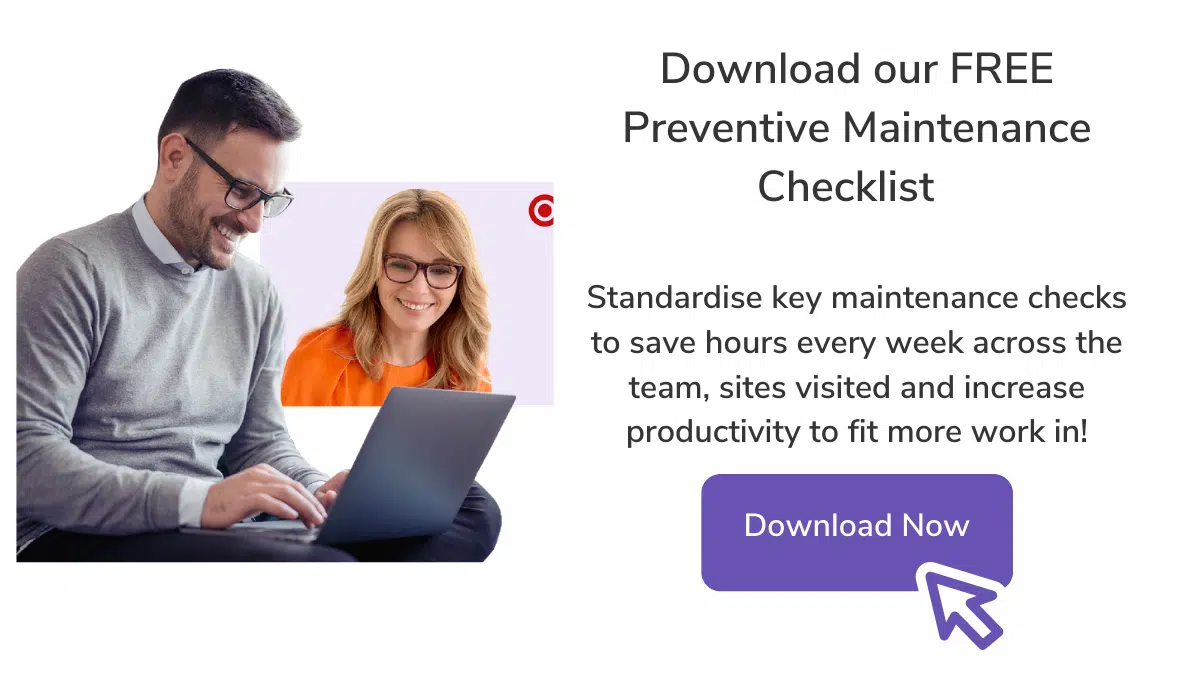Difference between Preventive and Breakdown Maintenance
Just like murder, preventive maintenance is premeditated – you plan to clean and service your customer’s assets to avoid breakdowns. Breakdown Maintenance however is based on the physical breakdown of an asset before scheduling the maintenance. To break apart the different types of maintenance, we discuss the top 4 differences between them and the main factors to consider for your HVAC business.
What is Preventive Maintenance?
Preventive maintenance is all about regularly scheduled maintenance work that is based on a contract or service agreement. Preventive maintenance aims to make regular contact with an asset to avoid defects and keep performance levels stable. This style of maintenance has a key focus in minimising defects and reducing unplanned equipment downtime.
A preventive maintenance structure will follow the basics of:
- Begin maintenance contract with customer
- Decide on schedule and maintenance consistency (3 monthly, 6 monthly, annually)
- Complete scheduled maintenance of assets and reports
- Keep assets performing with no unplanned downtime
Examples of preventative maintenance include the scheduled servicing of a water heater, refrigeration units of any size of use (residential, commercial or industrial). Maintenance for an annual schedule would consist of inspecting pressure valves, replacing the anode rod and flushing the system to ensure minimal downtime and failures for your client’s assets.
With tools such as a HVAC maintenance checklist, you can manage your maintenance schedule and system to reap the maximum benefits for your business.
What is Emergency Maintenance?
Emergency maintenance (also known as breakdown maintenance or corrective maintenance) focuses on fixing a defect after it occurs. Breakdown maintenance isn’t planned in advance of a defect but will occur after unplanned downtime. Similarly to predictive maintenance, an emergency maintenance program will also be triggered by the condition of the asset.
An emergency/breakdown maintenance structure will look something along the lines of:
- Asset breakdown
- Client calls technician to site
- Detect and analyse to find fault
- Fix asset
This example of maintenance can include simple maintenance like changing light bulbs. Changing light bulbs is one example of maintenance that doesn’t require preventive actions, but gets the most benefit from a breakdown maintenance plan.
Top 4 Differences Between Preventive And Breakdown Maintenance
To decide what maintenance plan works best for you, weighing the facts and differences between preventive vs breakdown maintenance can help you determine what your business needs.
1. Systems
When looking at the systems in place for both preventive and upkeep maintenance management, they vary based on their triggers. While a preventive maintenance strategy will focus on a set scheduled contract, a breakdown maintenance program will base their work from the performance of an asset.
A preventive maintenance program will need an asset maintenance system in place to work effectively and schedule your maintenance work. Preventive maintenance will focus on:
- Building an Asset Register
- Maintenance Contract Management
- Building Maintenance Tests
- Maintenance Scheduling of assets and Tests
- Asset Maintenance Testing in the Field
- Asset Maintenance Test Reports
- Follow Defect Quote workflow
- Monthly Billing
While breakdown maintenance tasks will focus on:
- Scheduling Just in Time
- Trained Technicians that can troubleshoot
- Purchase Order workflow on the run
- Service Reports
- Timesheets
- Do & Charge billing
2. Service Level Agreements (SLAS)
Maintenance requirements in the HVAC industry such as SLA’s can also be a varying factor in equipment failure and maintenance tasks. Determining what types of assets your clients have will affect the way you program your maintenance.
Preventive maintenance with fixed intervals will reduce the chance of voiding warranty or contracts through regular maintenance where asset performance can be monitored.
Breakdowns however can void warranty due to equipment failures as a result of no maintenance. When considering what maintenance management is right for your business, this is an important consideration.
Fire asset management has variable intervals and can have maintenance tolerances similar to this.
3. Responsiveness
Breakdowns and equipment failure are important issues in any HVAC business and by having great operations in place to timely meet SLAS, you can improve your responsiveness. When you have a great response time and can provide a fast and responsive service you will build good will and generate more work.
Preventative maintenance will help reduce your workload in the more busy periods by moving your maintenance tasks to the quieter months. This frees up more time in the peak seasons (summer and winter) where you will typically have more equipment breakdowns and hence a higher response rate.
Emergency maintenance teams on the other hand, may find themselves inundated with work orders during peak seasons and their response time can sometimes suffer because of this.
4. Predictability
Preventive maintenance allows you to generate a predictable income and generate low cost additional work.
A breakdown maintenance service life will typically generate less predictability in your workflow as you are relying on equipment failure before you gain any work. In this type of maintenance, you will find the maintenance costs can be more unpredictable than a preventive method.
The Cost Factor Difference between Preventive Maintenance and Breakdown Maintenance
Preventive Maintenance Costs
Preventive maintenance is a proactive approach to maintaining equipment and involves regular inspections, adjustments, and part replacements. This approach typically has higher upfront costs due to the need for regular maintenance, but it can lead to significant long-term savings by reducing unexpected downtime and costly repairs.
Breakdown Maintenance Costs
Breakdown maintenance, also known as reactive or corrective maintenance, is performed after a failure or malfunction has occurred. This approach often has lower initial costs since maintenance is only conducted when required, but the long-term costs can be much higher due to the increased risk of equipment failure and potential downtime.
The Role of Maintenance Technicians
Preventive Maintenance Expertise
In preventive maintenance, technicians play a critical role in identifying potential issues before they become problems. Their expertise in conducting routine inspections, making adjustments, and recommending part replacements helps to keep equipment in optimal condition and prevent unexpected breakdowns.
Breakdown Maintenance Expertise
In breakdown maintenance, technicians are primarily focused on diagnosing and repairing equipment that has already failed or malfunctioned. Their expertise in troubleshooting and repairing equipment is essential to minimize downtime and restore the asset to working condition as quickly as possible.
Asset Lifespan and Performance
Preventive Maintenance and Asset Longevity
Preventive maintenance can lead to an extended lifespan for assets, as it helps to identify and address potential issues before they result in significant wear and tear or catastrophic failure. Regular maintenance also helps to maintain the performance of equipment and ensure that it operates efficiently throughout its life.
Breakdown Maintenance and Asset Longevity
Relying solely on breakdown maintenance can result in a shorter lifespan for assets, as equipment is more likely to experience unexpected failures and require costly repairs. Breakdown maintenance does not address the root causes of equipment wear and tear, which can lead to decreased performance and efficiency over time.
Real-Life Examples and Scenarios
Preventive Maintenance in Practice
An example of preventive maintenance in practice is the regular servicing of a vehicle’s engine. By scheduling routine oil changes, filter replacements, and tune-ups, drivers can prevent major engine problems and extend the life of their vehicle.
Breakdown Maintenance in Practice
A common example of breakdown maintenance is the repair of a broken-down vehicle. In this case, the driver would not have conducted regular preventive maintenance, resulting in the vehicle experiencing a failure that requires immediate attention and repair.
Safety and Risk Management
Preventive Maintenance and Safety
Preventive maintenance can improve safety by identifying and addressing potential hazards before they lead to accidents. Regular maintenance can help to prevent equipment malfunctions that could result in injury or damage to property.
Breakdown Maintenance and Safety
Relying on breakdown maintenance can increase the risk of accidents and injuries, as equipment is more likely to experience unexpected failures. This approach may not address potential hazards until after an incident has occurred, which can result in costly repairs and increased risk to personnel and property.
Breakdown Maintenance vs Preventive Maintenance – Key Takeaways
- Importance of maintenance: Maintenance is crucial for the longevity and efficiency of equipment, reducing the likelihood of unexpected breakdowns and minimizing downtime.
- Preventive maintenance: A proactive approach that involves regular inspections, adjustments, and part replacements to prevent failures before they occur. This method requires careful planning, scheduling, and investment in maintenance tasks.
- Breakdown maintenance: Also known as reactive maintenance, this method is performed after a failure occurs. It can be cost-effective for non-critical equipment but may result in longer downtimes and higher repair costs for critical equipment.
- Choosing the right maintenance strategy: The choice between preventive and breakdown maintenance depends on various factors, such as the type of equipment, its criticality, and the overall maintenance budget.
- Key differences: Preventive maintenance focuses on preventing failures through proactive actions, while breakdown maintenance deals with failures as they occur. Preventive maintenance requires more planning and scheduling, while breakdown maintenance can result in higher repair costs and longer downtimes.
- Considering other maintenance strategies: It’s essential to explore other maintenance strategies, such as predictive and condition-based maintenance, to optimize the maintenance process further and improve overall equipment efficiency.
By understanding the differences between preventive and breakdown maintenance, organizations can make informed decisions about which strategy to adopt for their specific needs, ultimately improving equipment performance and reducing maintenance costs.
What You Should Do Now
- Book a Demo. You’ll be in touch with an automation expert who has worked in this space for over 5 years, and knows the optimal workflow to address your needs.
- If you’d like access to free articles about managing HVAC workflows, go to our blog.
- If you know someone who’d enjoy reading this page, share it with them via email, Linkedin, Twitter, or Facebook.





